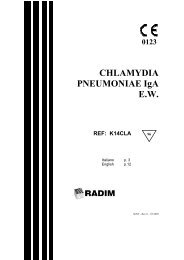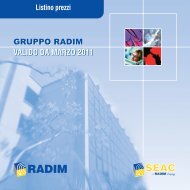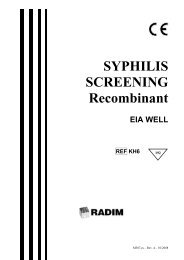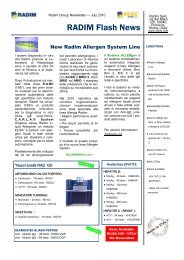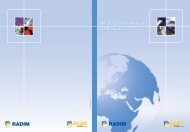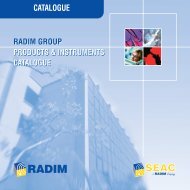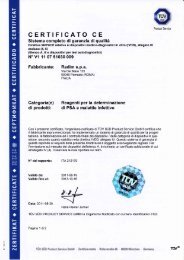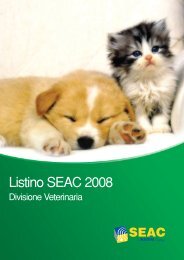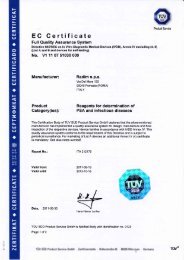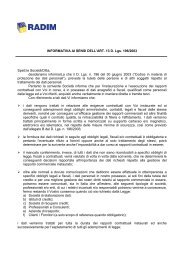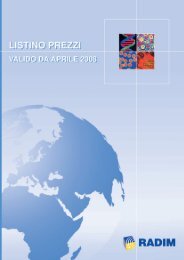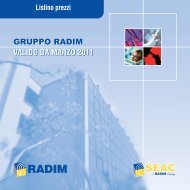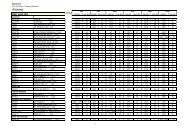ALLERGEN Total IgE REF - Radim S.p.A.
ALLERGEN Total IgE REF - Radim S.p.A.
ALLERGEN Total IgE REF - Radim S.p.A.
Create successful ePaper yourself
Turn your PDF publications into a flip-book with our unique Google optimized e-Paper software.
ENZYME IMMUNOASSAY FOR QUANTITATIVE DETERMINATION OF TOTAL <strong>IgE</strong> IN HUMAN<br />
SERUM AND PLASMA<br />
FOR IN VITRO DIAGNOSTIC USE ONLY<br />
1.0 INTENDED USE<br />
The <strong>ALLERGEN</strong> <strong>Total</strong> <strong>IgE</strong> is an enzyme immunoassay kit for the quantitative determination of total<br />
Immunoglobulins of type E (<strong>IgE</strong>) in human serum or plasma. It is strictly for in vitro diagnostic use only<br />
and the obtained results should be used in conjunction with other data available to the physician.<br />
2.0 SUMMARY AND EXPLANATION OF THE TEST<br />
The Immunoglobulins belonging to E class (<strong>IgE</strong>) contain 2 types of polypeptide chains, have a molecular<br />
weight of approximatively 200.000 (1) and bind to surface of mast cells and basophilic granulocytes. The<br />
binding of allergens to cell-bound <strong>IgE</strong> causes these cells to release histamine and other vasoactive<br />
substances, thereby initiating the events recognized as allergic reactions (1,2,3). Most patients with<br />
atopic allergic diseases, such as atopic asthma, atopic dermatitis and hay fever have been shown to<br />
exhibit an increase of total <strong>IgE</strong> levels in blood (4,5,6). Non-allergic individuals have <strong>IgE</strong> concentrations<br />
that vary widely, and during childhood they normally show increase, reaching adult levels in the second<br />
decade of life (7,8). Measurement of total <strong>IgE</strong> concentration may be of value in the early detection of<br />
allergy in infants, and as a means for predicting future atopic manifestations (9,10,11). Significant<br />
elevation may be found not only in allergic patients, but also in cases of <strong>IgE</strong> myeloma, pulmonary<br />
aspergillosis, and during the active stage of parasitic infestations (12,13). Increased levels of <strong>IgE</strong> are<br />
found in cases of hypergammaglobulinemia, autoimmune diseases, ulcerative colitis, hepatitis, cancer<br />
and malaria (14).<br />
3.0 PRINCIPLE OF THE TEST<br />
The <strong>ALLERGEN</strong> total <strong>IgE</strong> is based on the enzyme immunoassay, sandwich principle. The testing sample<br />
is added to the monoclonal anti-human-<strong>IgE</strong> antibodies coated onto the wells of the microstrips. During<br />
the first incubation the solid phase anti-<strong>IgE</strong> captures the sample <strong>IgE</strong>. The addition and subsequent<br />
incubation with an Anti-<strong>IgE</strong>-Biotin conjugate lead to the formation of the sandwich: solid phase-Anti-<strong>IgE</strong> :<br />
<strong>IgE</strong> : Anti-<strong>IgE</strong>-Biotin. The further incubations with the Streptavidin-Peroxidase conjugate and then with<br />
the substrate chromogen, respectively, lead to a blue color development. The enzymatic reaction is then<br />
blocked with a stop solution which turns yellow the blocked solution. The resulting colour is read<br />
photometrically at 450 nm. The concentration of sample <strong>IgE</strong> is directly related to the colour intensity.<br />
4.0 KIT COMPONENTS<br />
MT PLATE<br />
CONJ│BIOT<br />
CAL│A…F<br />
BUF│INC<br />
DIL│SPE<br />
CONJ│HRP<br />
Reagents<br />
Microplate sensitized with anti-<strong>IgE</strong>: one bag containing 12 strips x 8 wells,<br />
coated with monoclonal (mouse) anti-human <strong>IgE</strong>. Store the unused strips at<br />
2…8°C in the plastic zip pouch with the desiccant.<br />
Anti-<strong>IgE</strong>-Biotin Conjugate: one vial (13 ml) of anti-<strong>IgE</strong>-Biotin conjugate in TRIS<br />
buffer, pH 8.1, preservatives and stabilizers. Ready to use.<br />
Calibrators for <strong>Total</strong> <strong>IgE</strong>: 6 Vials, 0.5 ml each. The vials contain human <strong>IgE</strong> in<br />
horse serum with 0.01% of Proclin 300 as preservative. The <strong>IgE</strong> concentrations<br />
are: 0 - 10 - 50 - 250 - 500 - 1000 KIU/L. (WHO 2 nd IRP 75/502). Ready to use.<br />
Incubation Buffer: one vial (18 ml) containing TRIS buffer, pH 8.4, with 0.1% of<br />
Tween 20 and 0.005% of Proclin 300 as preservative. Ready to use.<br />
Sample Diluent: one vial (10 ml) of sample diluent consisting of horse serum, with<br />
0.01% of Proclin 300 as preservative. Ready to use.<br />
HRP-Streptavidin Conjugate: one vial (13 ml) of Streptavidin-Peroxidase<br />
conjugate in a red colored buffer, pH 5.5 supplemented with 0.001% Proclin 300.<br />
Ready to use.<br />
A1002 – <strong>ALLERGEN</strong> <strong>Total</strong> <strong>IgE</strong><br />
M541 – Rev. 1 – 06/2010 – Pag. 11/32



